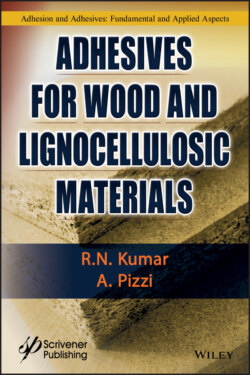Читать книгу Adhesives for Wood and Lignocellulosic Materials - R. N. Kumar - Страница 35
1.9 Effect of Processing Parameters on Penetration
ОглавлениеProcessing factors that can influence the adhesive penetration are open assembly time, pressing time, temperature, and consolidation pressure involved in wood-based composite manufacture. There can be a complex interaction between processing parameters, adhesive formulation, and wood characteristics. Sernek et al. reported increasing penetration of UF resin into beech as open assembly was increased [31]. Temperature influences penetration by affecting resin viscosity and cell wall permeability. At the same time, in the case of thermosetting adhesives, polymerization increases viscosity, countering the temperature effect on liquid viscosity.
White studied the influence of consolidation pressure (from 3 to 1000 kPa) on penetration and consequently on the fracture toughness of southern pine blocks bonded with resorcinol-formaldehyde [52]. Increasing consolidation pressure increased penetration into earlywood, but had an erratic effect on latewood. Low permeability of the latewood may result in the adhesive squeezing of the adhesive out of the bondline during consolidation. Increasing consolidation pressure reduced fracture toughness of the latewood specimens but had no significant influence on the earlywood specimens.
Johnson and Kamke [54] reported increased penetration of PF into yellow-poplar strands as a result of steam injection pressing. The authors suggested that condensate from the steam dilutes the resin and steam pressure forces the resin deeper into the wood.
The use of radio-frequency heating of a veneer composite caused a reduction in penetration of UF resin in comparison to matched samples produced using conduction heat in a platen [31]. The authors noted that the rate of polymerization was much faster using radio-frequency heating and thus reduced the time for penetration.
